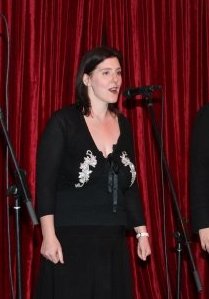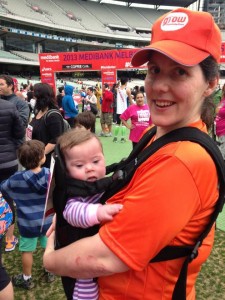 Peggy Hooper’s involvement with Grow Foundation began when she performed an Opera solo at our Foundation Launch in February 2011. So, two years later, when Peggy and her husband welcomed their third child Jacinta into the world – and discovered she had Down syndrome, Peggy knew exactly what to do.
Peggy Hooper’s involvement with Grow Foundation began when she performed an Opera solo at our Foundation Launch in February 2011. So, two years later, when Peggy and her husband welcomed their third child Jacinta into the world – and discovered she had Down syndrome, Peggy knew exactly what to do.
1. How did you feel when you were told of your child’s brain injury and prognosis?
We found out that our daughter had Trisomy 21 (Down syndrome) at birth. We were not given any prognosis at that point or any other point. The first thing to do was keep her alive while her body sorted itself out. We were lucky in that the medical providers never wrote her off in any way. We were also lucky that I had been helping to promote the IAHP seminar, having seen what it had done for a friend’s son. As soon as I heard the words I mentally wrote off the next few years, as I knew it could be a long road but that we could get to where we wanted to and anything was still possible.
2. What treatments / service providers did you initially look to?
We didn’t write anything off. Initially we had to get her into shape because she had a heart defect which affected her breathing and in turn her feeding. She had a nasogastric tube and had open heart surgery at 4 months. We were signed up to the early intervention service and I deferred our place since it wasn’t the right time, although I wasn’t planning to use the physio at all! We did also look at supplementation and NAET.
3. Did you notice any changes attributable to your treatment?
During the time she was waiting on the heart surgery she was mostly on her back. I had read enough of the philosophy of IAHP and knew that this was not the best course of action, but in hospital with tubes and with a chest wound, there isn’t much alternative. Her mobility was certainly stunted, although I maximised opportunities to exercise her eyes and her grasp. The NAET helped with her mentally while she couldn’t move and helped with healing her organs and supporting her physical systems.
4. What motivated you to look for alternative treatments and find IAHP?
As mentioned earlier, I was motivated before I even met my daughter so the night she was born I emailed the organiser and signed up. There was no question at all since I’d seen the results first hand. I am all for alternative treatments!
5. How did you feel when they demystified the world of brain injury for you?
The information contained in that one unit made so much sense and completely broke down any difficulty I had in understanding what goes on in the brain. I started to feel empowered and in control of my daughter’s condition. After the first day on the course my own head felt full as though my brain had grown from all the information!
6. As you first worked out what commitment to the program you would need to make, how did you feel?
I was lucky again since I did the numbers and realised that the work we had done up to that point had stood our daughter in good stead and we just needed to build on that. This was encouraging. However there were so many things that I wanted to do, it was like being a kid in a lolly shop, with all the different things to choose from. I also began to see ways I could help my other children too and wanted to involve them too. A very important thing that the course gave me was the feeling that I was in control of things. I was the one to choose what we did and when and how much. I had all the tools to use and it was up to me to work out how to use them.
7. As things progressed did it feel easier to live the program as results started showing?
I am a cautionary tale in this section, as my husband had his university exams the week of the course and could not attend. This meant that I was the only one who had done it and this has meant that the whole family is not on board. I am incredibly glad that I have the tools to help and I can, but without my husband’s full support, and his own health problems taking priority, we have not been able to implement the programs properly. I know that for us we need to get my husband to the course to have the whole family fully on board. Despite this, from the little that I have done, my daughter’s eyesight is very good and her grasp is strong.
8. Did you believe that these results were possible?
I knew that these results were possible and I know that even better results are possible still!
9. Do you now think that some of the physical aides people try and sell could have provided the same result?
I don’t see how they could. There were some equipment pieces brought out by the early intervention people, but the focus was all on manufacturing micro-stages rather than supporting a child’s natural progression through the stages of development and allowing the brain to grow to its full extent. When you bypass the brain’s proper developmental path, you might get an activity happening, but it doesn’t benefit the child’s neurological health.
10. Would you do it all again if another brain injured child was put into your care?
Yes, absolutely.
11. What would you say to a parent who might be considering attending the What To Do About Your Brain Injured Child Course?
You need to go to the course. There is no way to imagine what you will learn or how much you will know by the end. I came away with a full understanding of essential brain function, what is wrong with my child’s brain, where the trouble lies, how to fix those exact problems and how to get started with it all. There was a lot of emphasis on how to get started and doing as much as you can do. Another thing is that I nearly didn’t go because my 5 month-old daughter was still exclusively breastfed and didn’t take a bottle at all. I had no idea how I would manage to keep her fed during the day. Thankfully the organisers had experience with this scenario and made sure there was a space available very close to the auditorium so I could feed between sessions. It was a very busy schedule but it allowed me to do the course and looking back, I’m very glad I didn’t let that stop me.
Is there anything else you would like to tell us about your experiences as a ‘programming’ parent, working with your own child?
Simply that in my experience, both parents need to go. Being the lone parent who has done the course has put me in the position of trying to motivate the rest of the house while running the house and trying to put a program together. In our house, to be on the same page, we need both of us to have done the course.
Peggy Hooper.
For more information about the ‘What To Do About Your Brain Injured Child’ Course, visit www.iahp.org.au


